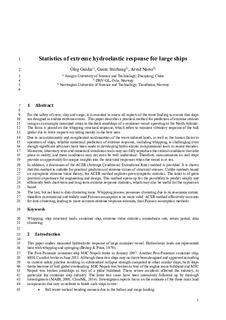| dc.contributor.author | Gaidai, Oleg | |
| dc.contributor.author | Storhaug, Gaute | |
| dc.contributor.author | Næss, Arvid | |
| dc.date.accessioned | 2019-02-11T14:25:23Z | |
| dc.date.available | 2019-02-11T14:25:23Z | |
| dc.date.created | 2018-11-19T20:19:12Z | |
| dc.date.issued | 2018 | |
| dc.identifier.citation | Marine Structures. 2018, 61 142-154. | nb_NO |
| dc.identifier.issn | 0951-8339 | |
| dc.identifier.uri | http://hdl.handle.net/11250/2584860 | |
| dc.description.abstract | For the safety of crew, ship and cargo, it is essential to assess all aspects of the wave loading to ensure that ships are designed to endure extreme events. This paper describes a practical method for prediction of extreme stresses using as an example measured strain in the deck amidships of a container vessel operating in the North Atlantic. The focus is placed on the whipping structural response, which refers to transient vibratory response of the hull girder due to wave impacts occurring mainly in the bow area.
Due to non-stationarity and complicated nonlinearities of the wave induced loads, as well as the human factor in operation of ships, reliable numerical prediction of extreme response, including whipping, is challenging even though significant advances have been made in developing hydro-elastic computational tools in recent decades. Moreover, laboratory tests and numerical simulation tools may not fully reproduce the critical conditions that take place in reality, and these conditions may not even be well understood. Therefore, measurements on real ships provide an opportunity for unique insights into the structural responses when the vessel is at sea.
In addition, a discussion of the ACER (Average Conditional Exceedance Rate) method is provided. It is shown that this method is suitable for practical prediction of extreme values of structural stresses. Unlike methods based on asymptotic extreme value theory, the ACER method explores pre-asymptotic statistics. The latter is of great practical importance for engineering and design. This method opens up for the possibility to predict simply and efficiently both short-term and long-term extreme response statistics, which may also be useful for the captain on board.
The last, but not least is data clustering issue. Whipping process possesses clustering due to its resonance nature; therefore conventional and widely used Poisson assumption is no more valid. ACER method effectively accounts for data clustering, leading to more accurate extreme response estimate, than Poisson assumption methods. | nb_NO |
| dc.language.iso | eng | nb_NO |
| dc.publisher | Elsevier | nb_NO |
| dc.rights | Attribution-NonCommercial-NoDerivatives 4.0 Internasjonal | * |
| dc.rights.uri | http://creativecommons.org/licenses/by-nc-nd/4.0/deed.no | * |
| dc.title | Statistics of extreme hydroelastic response for large ships | nb_NO |
| dc.type | Journal article | nb_NO |
| dc.type | Peer reviewed | nb_NO |
| dc.description.version | acceptedVersion | nb_NO |
| dc.source.pagenumber | 142-154 | nb_NO |
| dc.source.volume | 61 | nb_NO |
| dc.source.journal | Marine Structures | nb_NO |
| dc.identifier.doi | 10.1016/j.marstruc.2018.05.004 | |
| dc.identifier.cristin | 1632363 | |
| dc.description.localcode | © 2018. This is the authors’ accepted and refereed manuscript to the article. Locked until 29.05.2020 due to copyright restrictions. This manuscript version is made available under the CC-BY-NC-ND 4.0 license http://creativecommons.org/licenses/by-nc-nd/4.0/ | nb_NO |
| cristin.unitcode | 194,63,15,0 | |
| cristin.unitname | Institutt for matematiske fag | |
| cristin.ispublished | true | |
| cristin.fulltext | postprint | |
| cristin.qualitycode | 2 | |

